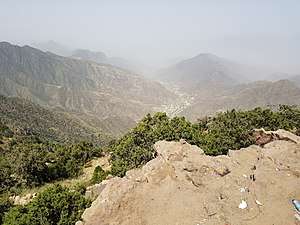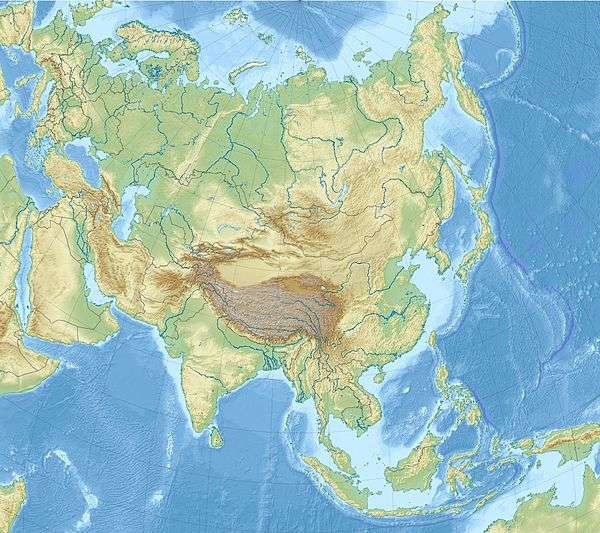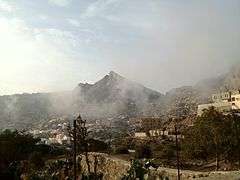Asir Mountains
The Asir Mountains[1] (Arabic: جِبَال ٱلْعَسِيْر, jibāl al-ʿasyr; Arabic pronunciation: [ʕsiːr] ('Difficult')) is a mountainous region in southwestern Saudi Arabia running parallel to the Red Sea. It comprises areas in the 'Asir Region of Saudi Arabia, however it also generally includes areas near the Yemeni border. The mountains cover approximately 100,000 square kilometres (40,000 sq mi) and consists of mountains, plains, and valleys of the Arabian highlands.[2] Sensu lato, they are part of the Sarawat Mountains,[3] defining the latter as the mountain range which runs parallel to the Tihamah throughout the western portion of the Arabian Peninsula, particularly the western parts of Saudi Arabia and Yemen.[4][5][6]
| Asir Mountains | |
|---|---|
 View from the summit of Jabal Sawdah ("Mount Sawdah") | |
| Highest point | |
| Coordinates | 21.6°N 39.8°E |
| Naming | |
| Native name | جِبَال ٱلْعَسِيْر (in Arabic) |
| Geography | |
 Asir Mountains  Asir Mountains | |
| Country | |
Geology

The mountains consist primarily of sedimentary rock, limestone, sandstone and shale, of Jurassic, Cretaceous and Paleogene origin on a Precambrian granitic basement.[2]
Climate and agriculture
The region has the highest average rainfall of Saudi Arabia due to largely seasonal rain. Average rainfall can range from 600 millimetres (24 in) to over 1,000 millimetres (39 in) per year, in wet regions. The eastern plains and plateaus receive much lower amounts, from 500 millimetres (20 in) to below 100 millimetres (3.9 in) per year.[2]
The region's crops, most of which are cultivated on steeply terraced mountainsides, include wheat, coffee, cotton, indigo, ginger, vegetables, and palms. The region also supports cattle, sheep, goats, and camels.
Biodiversity
The region's difficult terrain has helped preserve the region's unique biodiversity. Several new Myxomycetes fungi species have been discovered in the region, as have a variety of previously undiscovered plants.[7] Asir is also thought to be one of the last natural habitats of the Arabian leopard.[2][5][6]
Gallery
 Mountains near Abha
Mountains near Abha Landscape of Al-Habalah
Landscape of Al-Habalah
 Jabal Atherb, as seen from Ḥawālah in Bareq
Jabal Atherb, as seen from Ḥawālah in Bareq
See also
References
- "Library of Congress Country Study: Saudi Arabia", The Library of Congress, archived from the original on 2008-09-23
- "Southwestern Arabian montane woodlands". Terrestrial Ecoregions. World Wildlife Fund.
- Overstreet, William Courtney (1977). Tertiary laterite of the As Sarat Mountains, Asir Province, Kingdom of Saudi Arabia. 2. Directorate General of Mineral Resources. pp. iii–2.
- Nasr, Seyyed Hossein (2013). "1: The Holiest Cities of Islam". Mecca the Blessed, Medina the Radiant: The Holiest Cities of Islam. Tuttle Publishing. ISBN 1-4629-1365-2.
- Judas, J.; Paillat, P.; Khoja, A.; Boug, A. (2006). "Status of the Arabian leopard in Saudi Arabia" (PDF). Cat News. Special Issue 1: 11–19.
- Spalton, J. A. & Al-Hikmani, H. M. (2006). "The Leopard in the Arabian Peninsula – Distribution and Subspecies Status" (PDF). Cat News (Special Issue 1): 4–8.
- Boulos, L. (1985), "Myxomycetes from the Asir Mountains, Saudi Arabia (abstract)", A contribution of the flora of the Asir Mountains, Saudi Arabia, 3, Arab Gulf Journal of Scientific Research, pp. 67–94, archived from the original on February 29, 2012
.jpg)


